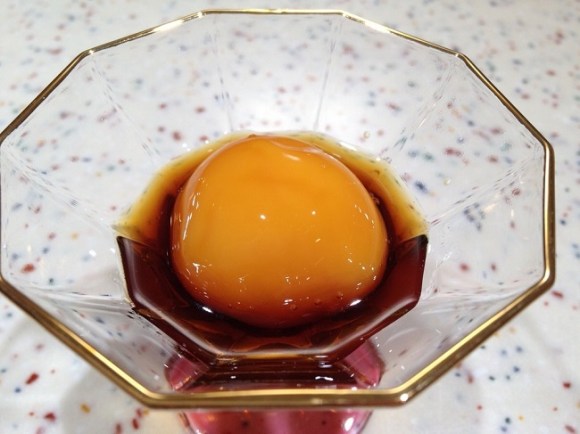
Japan seems like a heaven for lovers of raw food–you can even get raw horse meat, if you’re so inclined. Coming from the midwest of the US, I am seriously disinclined to touch any meat that’s not cooked well-done, especially if it comes from a formerly feathered friend. The very concept of “raw egg” is intrinsically linked to “death by salmonella” in my mind, despite the fact that raw egg dishes have been popular in Japan since long before I was born.
But knowing something logically and accepting it emotionally are two very different things. So, while I’m reluctant to try it, I’m that sure raw, frozen egg dishes are actually exceptionally tasty.
So, if you are interested in trying it, here’s some information on the dish and how to make it yourself.
Apparently raw, frozen eggs have become popular on the Japanese website Cookpad (English version here), a recipe-sharing site which boasts over 1,850,000 recipes. While not all of them are necessarily great, there’s probably more than a few excellent recipes if you’re looking for something good to cook.
And one of the bigger trends on Cookpad right now is raw, frozen egg dishes. While the very thought of it makes my stomach do backflips, it’s apparently a delicious way to enjoy your eggs–and easy to prepare as well! Raw egg dishes in Japan, like sukiyaki, usually involve unfrozen eggs, so it’s definitely a unique take on eggs. It does seem a bit more sanitary as well.
We should note that, at least in the recipes we’ve looked at, the eggs aren’t actually completely frozen when eaten–but they’re not entirely thawed either. However, “raw, almost-but-not-entirely-frozen eggs” would be a bit cumbersome, so I’ll just stick with “frozen!”
Now, let’s take a look at one of the most basic recipe for frozen eggs on Cookpad. You can even try it at home if you want, but we are absolutely not in any way responsible if you get sick!
First, the ingredients for two people are: Two eggs, a tablespoon of dashi shoyu (a mixture of stock and soy sauce that you can make yourself), and a tablespoon of shaoxing wine (which can be replaced with nihonshu if you prefer).
The steps involved are pretty easy too! First, take your two eggs, put them in a ziploc bag (since the shells will crack), and leave them in the freezer overnight. Once your eggs are thoroughly frozen, take them out and let them thaw for three hours at room temperature. They won’t be entirely thaw at this point, but they should be “mochipuri,” as described by the recipe, which is an onomatopoeia that roughly means “chewy and kind of firm.”
Next, separate the egg white from egg yolk, putting the latter into a dish with the dashi shoyu and shaoxing wine/nihonshu. Wrap the dish and let it sit for 15 minutes, being sure to flip the eggs half way through so that they soak up the sauce on both sides. Once time is up, you’re done and it’s time to eat! Just place the eggs in shallow dishes with a bit of the mixture and eat in small bites with chopsticks, spoons, or whatever utensil you prefer!
▼Putting the egg yolks in the mixture of dashi shoyu and wine.
▼Just waiting for 15 minutes
▼Itadakimasu!
The recipe also recommends adding some squid sashimi or sweet shrimp (ama-ebi) on top, if you’re feeling adventurous.
▼Well, I’ll say this. It does look good!
And there are a lot more uses for frozen eggs and frozen egg yolks, like using them as furikake for your rice!
Of course, even though these are (somewhat) frozen eggs, you should still use caution since they’re definitely raw and uncooked. Be sure to get fresh eggs from a trusted source! And let us know if you try this or any other frozen egg recipes. If you happen have your own version, be sure to share with everyone in the comments, too!
Sources: Cookpad (Ogunyanko), Huffington Post Japan
Images: Cookpad (Ogunyanko)